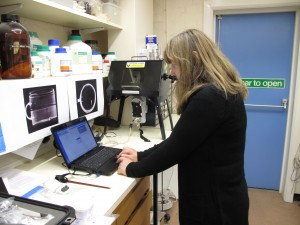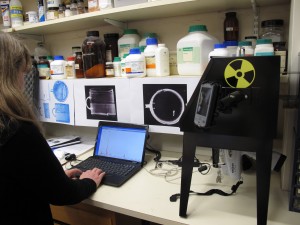On Monday last week I visited National Museums and Galleries Wales in Cardiff. With me I took two items I have mentioned previously on my blog the Iron Age bracelet/torc fragment (DUR-F3F8C4) and the Medieval mace head (DUR-5ACBE0).
I was meeting Mary Davies (Archaeological Conservator) and Adam Gwilt (Curator of Later Prehistory). They had both kindly agreed to give up some of their time to help me find out more about these two very interesting items. The museum in Cardiff has a great library and good scientific facilities for testing small finds, both of which are extremely useful when researching slightly unusual or rare objects.
Mary first put both items into the XRF machine (this stands for X-ray Flouresence and works by shooting X-rays at the item, depending on the chemical make-up of the object, a different spectrum is bounced back at the sensor). This was a portable XRF and so was quick and easy, it connected straight to a laptop and so allowed us to get easy to read graphs straight away. This method is qualitative only as it does not give exact amounts of each element but it does show the general proportions, i.e. in a copper alloy object the vast majority of the metal will be copper with small additions of tin, zinc, lead or other elements.


Next we went over the Archaeology Department at the University where they have an SEM machine. This is a special type of microscope, (a Scanning Electron Microscope), which means we can look at a tiny sample of an object at extremely high magnification. Electrons are shot at the sample and those which bounce back are again measured by the sensor and we can tell how much of each element is present (it is quantitative). Again the handy programme allowed us to get a graph of the elements and a table with the numbers.
Unfortunately the graphs and tables are stored in an excel file and I can;t get them onto my blog- however I will summarise the results below.
The Iron Age bracelet- was around 93% copper with c.6% tin with traces of lead, antimony and arsenic. This makes it a bronze and is a not unexpected alloy for this period.
The Medieval mace head- was around 83% copper, 8% tin and 5% lead with traces of other elements. The reason we tested this item was to help with the debate over whether these are Medieval or Bronze Age. Different alloys were used in different periods and so getting these items tested adds another element to our understanding of them. Unfortunately this alloy is not a typical Medieval alloy, although Mary did say it was more like Medieval alloys than Bronze Age so at least we have some tentative proof! The way forward with these items is to get more tested as it may turn out they were made with similar alloys (as I showed with my Wirral brooches, and others have shown with testing of other artefact types).